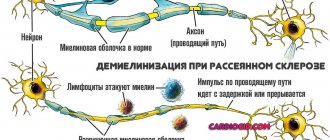Arterial hypertension
Arterial hypertension is one of the most common diseases among both men and women. In 90-95% of people suffering from this disease, the cause of hypertension cannot be identified, in which case hypertension is called primary or essential. As a rule, it develops gradually, at first without causing any visible symptoms, which is where its insidiousness lies, and later it affects many organs: kidneys, heart, brain, eyes.
In a small number of cases (5-10%), the cause of arterial hypertension is clearly defined: increased pressure develops due to the initial damage to any organ responsible for regulating blood pressure in the body. This is secondary arterial hypertension or symptomatic hypertension. Already in the very definition of “secondary”, symptomatic hypertension is not an independent disease, but a syndrome that occurs due to primary damage to the organ that regulates blood pressure in the body.
Why does the disease appear?
So, more details. Hypertensive syndrome develops against the background of other diseases. Among them:
- infectious and viral lesions of the membrane and the brain itself;
- head injuries;
- violation of the outflow of venous blood;
- cerebral edema;
- osteochondrosis;
- hydrocephalus;
- long anhydrous period or hypoxia;
- complications after childbirth and late pregnancy;
- neoplasms.
How does hypertension syndrome occur?
Hypertension is the modern name for increased intracranial pressure. Previously, the term "hypertension" was used. It occurs due to fluid pressure on the brain matter.
Hydrocephalus or cerebrospinal fluid hypertension syndrome, popularly known as “dropsy of the brain,” appears due to the accumulation of excess fluid in segments of the brain.
If hypertension and hydrocephalus develop in parallel, it is called hypertensive-hydrocephalic syndrome.
This disease of the brain is caused by the fact that cerebrospinal fluid (cerebrospinal fluid) collects in the ventricles of the brain and under its membranes, the outflow and reabsorption of which are disrupted.
This disease is considered independent in domestic medicine; foreign scientists consider the syndrome to be a companion to serious neurological ailments.
The structure and purpose of the human brain determines significant oxygen consumption, increased blood supply (blood flow to the four main arteries and its subsequent outflow through the veins), rhythmic transport of cerebrospinal fluid through the four cavities (ventricles) of the brain and between its membranes.
The ventricles are connected to each other by plexuses of blood vessels, which produce cerebrospinal fluid. Then it penetrates into the venous vessels and is produced anew.
Impaired movement of cerebrospinal fluid leads to excess venous blood, which causes an increase in the size of the ventricles.
Hypertensive hydrocephalic syndrome is diagnosed more often in infants and children than in adults.
Often the diagnosis is made by pediatric neurologists and pediatricians without any basis (in 97% of cases), since almost all of its symptoms are similar to those of neuropsychic excitability syndrome.
However, if hypertension and hydrocephalus are actually present, then vigilant parents will always notice it. In this case, the child:
- constant headache;
- he may feel nauseous and vomit like a fountain;
- he is often sad, lethargic, moody, tired;
- refuses to eat and always seems to be afraid of something.
More serious signs are:
- disturbances of consciousness;
- mental instability;
- mental retardation and developmental retardation;
- strabismus.
Signs of hypertension syndrome in infants can:
- bulge, strain and pulsate the fontanelle;
- sagittal sutures diverge;
- the head increases in size;
- the baby sucks weakly at the breast;
- his crying is like a groan;
- tremors or convulsions and even paralysis may occur.
In children over 1 year of age whose fontanelles have closed, hypertensive-hydrocephalic syndrome develops paroxysmally and quickly. Vomiting does not relieve the condition.
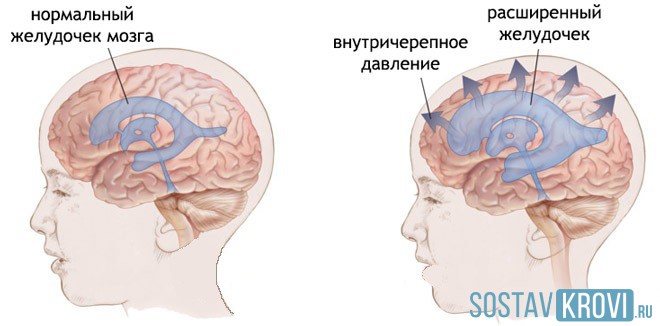
Children become:
- sedentary;
- irritable;
- an effect such as “the face of a sufferer” may be observed;
- vision deteriorates;
- the head is often fixed in one position.
You should also know that at any age a child may experience spontaneously occurring and also passing fluctuations in cerebrospinal fluid pressure.
Headaches, nausea and dizziness may be signs of other dysfunctions of the brain, the development of tumor processes, and other diseases.
This is the name of a pathological condition in which the amount of cerebrospinal fluid produced - cerebrospinal fluid - increases. In a healthy person, it accumulates in small volumes in the cerebral ventricles and within the meninges.
Due to this disorder, intracranial pressure increases. This leads to compression of the entire brain area and changes in cerebral hemodynamics. This diagnosis is one of the most common made by neurologists.
It cannot be ignored, because high blood pressure is always a sign of a serious illness.
How does it arise
It is worth noting that the concepts “hypertension” and “hypertension” are not synonymous. Although today one term often replaces another. They can be distinguished as follows:
- Intracranial hypertension is a broader concept that denotes the main symptom in the form of high blood pressure, for example, with vegetative-vascular dystonia. It is used only to state a fact.
- Hypertension, or essential hypertension, is an independent disease, the clinical sign of which is stable high blood pressure. It has nothing to do with other pathologies. Not all arterial hypertension is hypertension, but with hypertension there is always the fact of hypertension.
The human structure is designed in such a way that it is characterized by increased blood supply and rhythmic transport of cerebrospinal fluid between the membranes of the brain and through the ventricles. The latter are connected to each other by vessels.
They produce fluid, which subsequently enters the venous vessels and is synthesized anew. If the absorption or outflow of cerebrospinal fluid is impaired or it is produced in excess, it accumulates and enlarges the ventricles. Excess causes increased intracranial pressure.
This is hypertension syndrome, which has characteristic neurological features.
Depending on the age of the patient, the pathology is divided into a syndrome in newborns and in older children. In the first case, the disease is more difficult to diagnose, because the baby cannot talk about how he is feeling.
Doctors have to rely on the mother’s external signs and complaints. In infants, the syndrome occurs more often due to congenital causes. For older children, the acquired nature of the pathology is inherent.
They are more often diagnosed with mild or moderate hypertension.
If hypertension and hydrocephalus develop in parallel, the syndrome is called hypertensive-hydrocephalic. At an older age, it can be caused by traumatic brain injuries, viral diseases and infections, but the diagnosis is confirmed only in 3 cases out of 100.
In children, the syndrome manifests itself as severe headaches, which torment them in the morning and are accompanied by vomiting or nausea and dizziness. The sensations then begin to appear after physical activity. Further, the severity of the symptom increases, sometimes pain occurs and intensifies.
More often, hypertensive-hydrocephalic syndrome is diagnosed at an early age, mainly in newborns.

Risk factors include trauma during childbirth, infections during pregnancy, prematurity, and symptoms of brain damage.
During examination, a neurologist may notice an enlarging fontanelle and open sutures between the bones of the skull in the baby. In such a child, the head circumference increases faster.
In general, high intracranial pressure is not a cause of future problems with physical and mental development. Parents can notice the disease by the following clinical manifestations:
- restless behavior of the baby;
- disturbed sleep;
- constant crying;
- breast refusal;
- tremor;
- vomiting like a fountain;
- convulsions.
The main cause of increased intracranial pressure syndrome is stagnation of cerebrospinal fluid. This condition may be a consequence of the following diseases and cases:
- traumatic brain injuries;
- cerebral edema;
- hydrocephalus;
- prolonged oxygen starvation - hypoxia;
- violation of the outflow of venous blood;
- infections of the brain or its membranes;
- cerebral hemorrhages;
- malignant tumors in the brain;
- encephalitis;
- vascular hypotonicity;
- heredity.
Congenital
Due to congenital causes, hypertensive-hydrocephalic syndrome is more often observed in newborns. This pathology manifests itself in them due to:
- complications during pregnancy or childbirth;
- brain hypoxia;
- prematurity;
- subarachnoid hemorrhages;
- intrauterine infections;
- congenital brain defects;
- anhydrous period of more than 12 hours.
Purchased
Acquired causes are inherent in hypertensive-hydrocephalic syndrome, which develops in older children and adults. Their list includes:
- the presence of foreign bodies in the brain;
- infectious diseases;
- stroke and its consequences;
- endocrinological diseases;
- brain tumors, hematomas, abscesses, cysts in the brain;
- traumatic brain injuries;
- spontaneous increase in pressure.
In order to diagnose the disease in time, you need to know the symptoms that characterize hypertensive-hydrocephalic syndrome in adults. The main symptom is headache, which intensifies with prolonged exposure to the sun, after physical exertion and active movements with the head tilted. Other symptoms of pathology:
- Nausea. It is mainly felt in the morning and after eating fatty foods. Vomiting appears at once.
- Eye problems. Vision gradually begins to deteriorate. There may be double vision, a foggy veil appears, and the reaction to bright light is reduced.
- Fast fatiguability. Excitability may suddenly occur. A person gets tired even after minor exertion.
- Back pain. Covers the entire spine, accompanied by weakening of the muscles.
- Meteosensitivity. The condition of the body depends on the weather.
- Hyperesthesia. The disease is characterized by a constant sensation of itching under the skin. It feels like goosebumps are running all over your body
- Unstable blood pressure. Its jumps are noted against the background of increased heartbeat and sweating on the skin.
Diagnostic methods
Specialized medical institutions are involved in identifying hypertension syndrome. Medicine uses several methods to confirm such a diagnosis. Their list includes:
- echoencephalography and rheoencephalogram;
- X-ray examination of the skull;
- nuclear magnetic resonance and computed tomography;
- electroencephalography;
- examination of the fundus vessels;
- neurosonography;
- cerebral puncture.
The use of echoencephalography helps to accurately study the picture of brain performance. If there are pathologies, this method allows you to see them. This examination of the patient is based on ultrasound, thanks to which it is possible to determine the appearance of hypertension syndrome. A rheoencephalogram is a diagnostic method that evaluates the function and condition of cerebral vessels.
The procedure reflects the tension of their walls, elasticity, symmetry of blood supply and venous outflow. With hypertension, these indicators change, so a rheoencephalogram helps confirm the diagnosis. The procedure is carried out as follows:
- The patient's blood pressure is measured in a sitting position;
- then an elastic band is put on the head, passing over the eyebrows, ears and along the back of the head;
- Electrodes are attached above the eyebrows, behind the ears and in the occipital region;
- then a rheoencephalogram is recorded for a couple of minutes.
- July 13, 2018
- Cardiology
- Ksenia Yedikhanova
- Hypertension, hypertensive or hypertensive-hydrocephalic syndrome are alarming diagnoses, especially in modern environmentally unfavorable conditions and under constant stress.
- Sometimes, however, doctors can explain almost any patient complaints with these terms and frighten young parents with them.
- In fact, hypertension and hydrocephalus are truly complex conditions and require targeted, age-appropriate treatment, so you need to trust your health and the health of your children to a reliable, proven neurologist.
Symptoms
Clinical signs of hydrocephalus syndrome differ in newborns, older children and adults. The symptoms of the disease depend on the individual sensitivity of the body to changes in cerebrospinal fluid pressure and the general condition of the patients.
In children
Affected children are born in serious condition and have a low Apgar score. Acute development of the syndrome in infants is manifested by restlessness, crying, vomiting and confusion. A sick child does not take the breast well, screams and moans for no reason. In patients, the volume of the head quickly increases, the venous vessels on the head expand, the sutures of the skull diverge, the fontanel tenses, muscle tone decreases, innate reflexes weaken, tremors and convulsions appear, horizontal nystagmus, convergent strabismus is observed, and regurgitation is possible in a fountain. The gradual onset is characterized by a delay in the child’s psychophysical development.
Experts note a monthly increase in head circumference of 1-2 cm. The head of newborns takes on a specific shape - with an overhanging occiput or large frontal bumps. Enlargement and deformation of a child's head can be seen with the naked eye. When examining the fundus of the eye, swelling of the optic disc is detected.
The reaction of the eyeballs to the stimulus decreases, which sooner or later leads to complete blindness. Blood vessels are visible through the overstretched scalp. The bones of the deformed skull become thinner. Newborns experience incoordination of movements. Sick children cannot sit, crawl or hold their head up. Their psycho-emotional development is inhibited.
If left untreated, the syndrome is complicated by atrophy of brain tissue. In patients, the functions of the musculoskeletal system are first impaired, and then the visual analyzer and the thyroid gland. Gradually, sick children begin to lag behind their peers in development, and they develop mental disorders of varying severity.
In adults
Adults suddenly develop a dull and aching headache in the temples and forehead, tinnitus, paroxysmal dizziness, temporary disorientation in space, vomiting in the morning, limb cramps, and gait disturbances. They sleep restlessly, often shudder in their sleep, are overly excited or lethargic, apathetic.
Violations of the emotional-volitional sphere range from emotional instability, neurasthenia, causeless euphoria to complete indifference and apathy. In some cases, episodic psychoses with hallucinatory or delusional syndrome are observed. With a sharp increase in intracranial pressure, aggressive behavior is possible. The head becomes large due to chronic hypertension. Full-blooded blood vessels are clearly visible on it - the venous pattern is enhanced.
Pain in the neck, nausea, diplopia, a feeling of pressure on the eyes, blurred vision, loss of visual fields, and urinary incontinence may occur. Patients find it difficult to raise their eyes and lower their heads. Their skin turns pale, weakness and lethargy, lethargy, absent-mindedness, drowsiness, hypertonicity of the leg muscles, and squint occur.
During hydrocephalic syndrome, two options are possible:
- a favorable outcome of the pathology, which was based only on functional disorders - complete disappearance of symptoms within a year or their gradual regression,
- an unfavorable outcome is an increase in symptoms and the formation of a picture of organic brain damage with the development of hydrocephalus.
Complications of HS in children:
- epilepsy,
- violation of general development,
- delayed psychophysical development,
- loss of hearing and vision,
- coma,
- paralysis,
- difficulty moving,
- urinary and fecal incontinence,
- brain atrophy,
- dementia,
- weakness of the muscles of the arms and legs,
- thermoregulation disorder,
- violation of fat and carbohydrate metabolism,
- death.
The body’s powerful compensatory capabilities make it possible to achieve stabilization of the process by 2 years. Complete recovery without consequences is observed in 30% of cases.
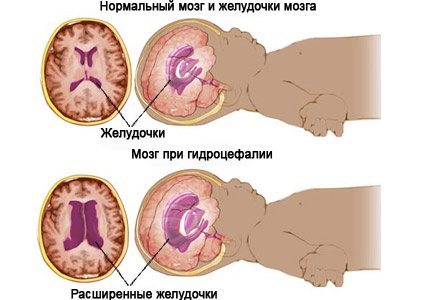
After a year, hydrocephalus clinically manifests itself somewhat differently. This is due to the loss of tissue elasticity and the presence of fused skull bones.
Hydrocephalus in children older than one year is characterized by the following clinical symptoms:
- Headaches, mainly in the morning;
- Nausea, often vomiting at the peak of the pain syndrome;
- Feeling of pressure in the eye sockets;
- Muscle twitching, chin trembling, motor pathologies;
- Impaired function of the urinary system in the form of episodes of urinary incontinence;
- Frequent mood swings, child's tearfulness for no apparent reason;
- Sleep disturbance (in the form of insomnia or lethargy and drowsiness);
- Mnestic disorders (deterioration of short-term memory);
- Violation of the child’s behavior (loss of interest in active games, communication, general development slows down);
If a child exhibits the symptoms described above, you should seek medical help for further examination and receive qualified treatment.
Hypertension syndrome in children, adults: causes, treatment
Unfortunately, during gestation and during labor, some complications may arise. Hypertension syndrome is one of them.
What is it, what dangers does it pose and what is the treatment?
Description
Hypertension syndrome in newborns is one of the most common neurological diseases in children. The disease is an increase in intracranial blood pressure. It can be a symptom of hydrocephalus, where excess cerebrospinal fluid accumulates in the lining of the brain.
There are 2 forms of the disease - acute and chronic. Acute is characterized by a sharp increase in pressure, which can lead to coma or severe brain damage. The chronic form manifests itself in a slight increase in intracranial pressure, which does not pose a particular danger to the child.
Development mechanism
Intracranial pressure is the difference between pressure inside the skull and atmospheric pressure. Normally, its values vary from 1.5 to 6 mm Hg. Art. for newborns and from 3 to 7 mm Hg. Art. for children aged 1 year and older. When these indicators increase, increased intracranial pressure is diagnosed.
According to the Monroe-Kelly doctrine, the cranial cavity is an enclosed space filled with fluids. Normally, it is 85% brain matter, 10% cerebrospinal fluid (CSF) and 5% blood.
If there is more of a substance, hypertension syndrome occurs. Most often this is cerebrospinal fluid.
Most patients with this diagnosis are cured within 6 months or 1 year. For some, increased intracranial pressure persists for life.
For such patients, it is important to visit a neurologist every six months to monitor the development of pathology and receive recommendations for eliminating symptoms.
Consultations also include X-rays of the head and fundus examination to monitor the pathological condition.
Hypertension syndrome is a pathological condition characterized by increased production of cerebrospinal fluid (CSF) within the meninges and ventricles. The consequence is an increase in intracranial pressure (ICP) with changes in cerebral hemodynamics. ICP is always a sign of a serious illness.
The brain has the most developed vascular network. CSF is formed inside the ventricles, which then circulates between the meninges. The constancy of the system is maintained by lymphatic formation and lymphatic drainage: old fluid is constantly replaced by new fluid.
But if the outflow process is disrupted, or hypersynthesis of cerebrospinal fluid occurs due to incorrect absorption, it accumulates in the ventricles, causing an increase in intracranial pressure.
A hypertensive syndrome occurs, which is dangerous in its consequences and debuts at any age.
High ICP in children is divided into hypertensive-hydrocephalic syndrome of newborns and older children. The first is the result of a congenital pathology; it is very difficult to diagnose due to the baby’s inability to talk about his feelings.
The pathology occurs more often in premature infants. Doctors focus only on the mother’s external signs and complaints. Visually: the child has an enlarging fontanel, open sutures of the skull.
When hydrocephalus occurs, the volume of the head grows disproportionately.
But intracranial pressure is not the cause of mental or physical retardation, the child simply behaves restlessly, constantly cries, his body is convulsed, spontaneous vomiting occurs, and refuses to breastfeed. This scares parents and makes doctors think about hypertension pathology.
Hypertension syndrome in older children can vary in severity and is sometimes associated with hydrocephalus. The cause may be injury, virus, or bacterial infection.
With intracranial hypertension, the severity of the manifestations increases, the pain increases in intensity, and appears after physical exertion.
Different causes of hypertensive-hydrocephalic syndrome require different treatment. It can be conservative or surgical.
Treatment begins after a complete diagnosis. Patients with this syndrome are required to be hospitalized without any options.
Drug treatment is based on patients taking medications that improve cerebrospinal fluid dynamics (diacarb, acetazolamide, and others).
Surgery is performed as a last resort if it is necessary to remove a blockage in the blood vessels of the brain or to perform a bypass. Most often, brain bypass surgery is used. The shunt will drain excess fluid into the spinal canal.
For hydrocephalus in adults, operations are most often performed to drain cerebrospinal fluid from the skull. The tumors are completely removed.
Drug treatment helps with neuroinfections (antibiotics). In adults, hypertensive-hydrocephalic syndrome cannot be treated with folk or homeopathic remedies, massage or acupuncture.
Incorrect treatment or ignoring it can lead to a decrease in the level of intellectual abilities, loss of vision and hearing, and death is also possible.
The most favorable prognosis for hypertensive-hydrocephalic syndrome in infants. In older children, everything depends on the adequacy of treatment and its timeliness.
Treatment is carried out on an outpatient basis using medications, as usual, Diacarb (the drug increases the outflow of cerebrospinal fluid and reduces the secretion of cerebrospinal fluid).
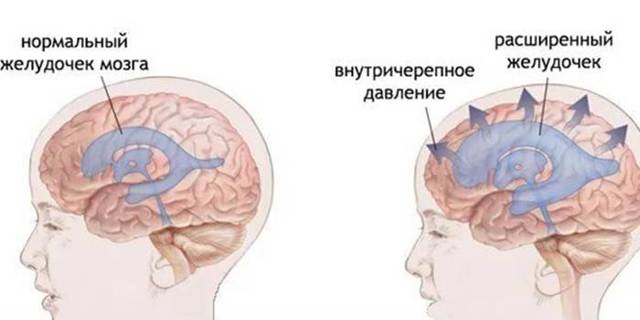
If diacarb does not help, and the disease progresses, then hospitalization in the neurosurgical department is indicated.
If there are changes of an unclear nature, it is very important to continue treatment correctly, since prescribing too serious medications or completely abandoning therapy will lead to negative consequences.
This disorder is also represented by the accumulation of excess fluid in the ventricles of the brain, which expand, pushing away the brain tissue and atrophying the hemispheres. This is hypertensive-hydrocephalic syndrome - a very terrible disease in which a person is doomed to lifelong shunt operations to remove excess fluid into the patient’s stomach.
Hypertension syndrome in newborns develops as a result of injuries received at birth, or the pathological course of pregnancy, prolonged lack of oxygen, or intrauterine infection with viruses. In this case, cysts form in the brain in utero, making it impossible for fluid to flow out of the brain. This diagnosis is confirmed even by an ultrasound machine (ultrasound examination).
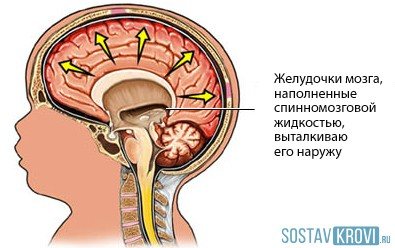
Features of hypertensive-hydrocephalic syndrome in children
Treatment of hypertension syndrome is a very labor-intensive process, the effectiveness of which is determined by the quality of detection of the disease and the competence of the doctor.
Gentle treatment is carried out at home and is focused on normalizing the discharge of fluid. Such treatment is justified if intracranial pressure increases slowly and does not threaten pathological processes. In this case, they use: antibacterial, diuretic, antiviral, vascular, angioprotective, antitumor drugs.
To eliminate the symptoms of brain compression, treatment is prescribed that increases the conductivity of neurons. In case of delay in the child’s development, special gymnastics is performed. Patients should also avoid any stress. Massages, acupuncture, and special exercises will be effective.
In case of a sharp deterioration of the condition, surgical intervention is performed, which consists of creating a hole in the vertebrae in order to drain fluid from the skull, or puncture the brain for hydrocephalus. If the cause of the disease is a neoplasm, then the operation will involve its removal.
Hypertension syndrome and its manifestations reduce the patient’s quality of life, and in children it leads to developmental arrest and degradation. Based on this, if you suspect this disease, you must immediately consult a competent doctor, since the prognosis for recovery directly depends on the severity of the symptoms, the speed of development, the causes and the quality of the treatment provided.
The symptoms of pathology in childhood and adulthood are almost the same. The most basic thing that the disease has in common across different ages is severe headaches. The pain can be described as tearing and bursting. Increased pain is observed with physical activity. At this moment, other symptoms are observed, the body’s thermoregulation is disrupted, breathing becomes more frequent and heart pain may appear.
Causes that cause the syndrome
The appearance of additional fluid or tissue that exceeds the space of the skull and compresses the brain.
Neoplasms, bleeding into the brain, impaired movement of cerebrospinal fluid, all kinds of trauma, infectious, inflammatory diseases, vascular damage to the brain, hypoxia, infection of the fetus in the womb, trauma at birth.
Most cases of hypertension syndrome in children and adults occur due to the occurrence of malignant or benign brain tumors, cysts, hematomas, abscesses, disturbances in the development of the circulatory system and large vasodilation, which leads to increased pressure and compression of the brain matter in the head.
An increase in intracranial pressure leads to cerebral edema as a result of stroke, meningitis, bruise, damage by toxic substances, or oxygen deficiency. Heavy flow of blood through the veins with damage to the vessels of the brain, pathologies of the vascular bed, defects in the bones of the spine leads to the accumulation of blood in the brain, which leads to a slow increase in pressure.
Doctors identify a number of causes for the syndrome:
- hypertensive-hydrocephalic syndrome can be caused by tumor processes in the brain;
- hematomas;
- hypotonicity of blood vessels;
- intracranial hemorrhages;
- various neuroinfections (meningitis, encephalitis);
- traumatic brain injuries;
- pathologies acquired at birth;
- heredity.
Thus, all causes can be divided into congenital and acquired.
Congenital causes of hypertension syndrome in adults are:
- complicated pregnancy and childbirth (gestational pyelonephritis, pregnancy diabetes, increased intracranial pressure, rapid and protracted labor, threatened miscarriage);
- brain hypoxia (bradycardia, fetal hypoxia and intrauterine developmental delay);
- prematurity (birth before 34-36 weeks) and late birth (42 weeks or more);
- subarachnoid hemorrhages (head injuries during childbirth);
- intrauterine infections (cytomegalovirus infection, Eppstein-Barr virus, toxoplasmosis and others);
- congenital brain defects (absence of a large part of the brain, formed hemispheres, presence of cysts, too small head size, abnormalities of the skull, brain stem);
- long waterless period (more than 12 hours).
Acquired causes include:
- hematomas, tumors, abscesses, cysts;
- the presence of foreign bodies in the brain;
- traumatic brain injuries with the presence of fragments of skull bones in the brain;
- spontaneous causeless increases in blood pressure;
- infections;
- strokes and their consequences;
- endocrinological problems.
Description of the disease
Hypertension syndrome explains most cases of headache.
An increase in intracranial pressure occurs against the background of stagnation of blood in the veins. The latter, in turn, often occurs as a result of the development of spinal pathologies in the cervical region, such as osteochondrosis. Excess cerebrospinal fluid, or cerebrospinal fluid, appears in the spinal cord stem, impairing circulation. As a result, cerebrospinal fluid stagnates in the ventricles of the brain and inside its membranes, which leads to an excess of blood in the veins with further expansion of the cavities occupied by fluid.
Other symptoms
Patients also experience a number of other symptoms. Namely:
- Nausea, often progressing to vomiting. This symptom most often appears in the morning;
- The patient usually gets very and quickly tired, even if there is practically no physical or intellectual stress. There is increased nervousness;
- Hypertensive syndrome is usually accompanied by vegetative-vascular dystonia. And these are changes in blood pressure, increased heartbeat, increased sweating and frequent fainting;
- As a rule, the patient has blue circles under the eyes. This symptom has nothing to do with lifestyle at all. If you stretch the darkened skin around the eyes, then dilated small vessels are clearly visible;
- Sexual desire is almost completely absent;
- When atmospheric pressure changes, the patient’s condition also worsens, that is, he becomes weather-sensitive;
- In the later stages of the disease, mental disorders are observed, manifested in personality changes and decreased intelligence;
- Brady or tachycardia may also appear in the later stages of the disease.
Attacks in the later stages develop according to the following pattern - at first the patient feels “stunned”, then periodically falls into a stop. In the end, everything can end in a coma.
It should be understood that the described signs of intracranial hypertension are subjective and do not confirm the presence of the disease. A person can only suspect the presence of a certain problem and must consult a doctor, who will make a diagnosis based on the results of diagnostic measures.
Classification
For convenient diagnosis and prescription of effective treatment, this pathology has been classified. Experts distinguish three stages of arterial hypertension:
- First stage of the disease. There are no significant changes in the organs and blood vessels, the patient’s general condition is stable.
- Second stage of the disease. Disorders are diagnosed in one or more organs susceptible to this pathology. The patient may experience a hypertensive crisis.
- The third stage of the disease. Violations in organs of a complex nature are diagnosed. The patient's risk of developing stroke and heart attack increases, the optic nerve is damaged, as a result, vision deteriorates, heart and kidney failure is observed, which are accompanied by additional symptoms.
Only a specialist can determine the extent of the disease after a thorough examination and analysis of the patient’s general condition.
Symptoms and signs that accompany the syndrome
The symptoms of hypertensive-hydrocephalic syndrome (signs) are as follows:
- headache;
- anxiety, insomnia;
- visual impairment;
- the appearance of a vascular session;
- deafness, loss of consciousness, coma;
- deviations in head size and others.
What is Ekbom syndrome and how to treat restless legs syndrome? What causes the disease and is it possible to help yourself at home? Why is grade 1 dyscirculatory encephalopathy difficult to diagnose and what symptoms and signs indicate the disease.
What is hypertension syndrome
Development mechanism
What should we say about kids? Hypertensive syndrome in children usually develops against the background of intrauterine hypoxia or after birth injuries. There are a number of other reasons for the development of the disease:
- fetal prematurity;
- decreased arterial blood flow and, as a result, ischemic brain damage;
- infections during fetal development;
- congenital brain defects;
- intracranial hemorrhage.

The disease is always accompanied by severe headaches. At an early age, children with the syndrome usually behave very restlessly, periodically cry and sleep poorly. During exacerbation, nausea and vomiting may occur. The main thing is that during treatment, intracranial pressure does not in any way affect the mental development of the baby.
At an older age, headaches are initially characterized by periodic attacks, but over time they constantly bother the child. An exacerbation is observed after physical exertion.
In a sick baby, you can observe an increase in the saphenous veins in the frontal region and near the temples. It is even possible that the large fontanel will become enlarged, and the sutures between the small fontanelle and the bones of the skull may be open. As a rule, the baby's head is disproportionately large and grows much faster than it should be.
Hypertension syndrome in adults and children may be accompanied by Graefe's symptom. That is, a strip of protein is observed on the iris of the eye.
Renal hypertension
Renal hypertension can be diagnosed at any age. Refers to the secondary type of the disease. It occurs as a result of many provoking factors and is accompanied by severe symptoms. It is worth understanding that the kidneys are a filtering organ, and if a patient is diagnosed with high blood pressure, the volume of blood passing through them also increases, thereby disrupting the function. The kidneys are not able to filter large amounts of blood and do their job efficiently, that is, remove harmful substances from the body.
Due to the disrupted process, the patient will experience an accumulation of fluid in the body and swelling will appear. Since the vessels are not able to work in this mode, renin is produced, which also provokes fluid retention in the body. In this case, the patient will be diagnosed with increased tone of the renal arteries. If kidney function is impaired, the synthesis of prostaglandin, which can normalize blood pressure levels, will decrease.
Diagnostic techniques
To diagnose this disease, a comprehensive clinical examination is mandatory. It includes examination by specialists and hardware tests.
Ophthalmologists, neurologists, psychiatrists, and neurosurgeons work with hypertensive-hydrocephalic syndrome.

To determine the cause of the disease, hardware tests are carried out such as:
- echoencephalography (EchEG) is a highly accurate diagnosis of brain lesions;
- rheoencephalogram (REG) – study of venous outflow of blood from the vessels of the brain;
- radiography of the skull (SCH) – used for long-term development of the disease in children over 1 year of age;
- nuclear magnetic resonance (NMR) and computed tomography (CT) - highly accurate determination of areas of disturbance in the dynamics of the cerebrospinal fluid, the size of the brain cavities, and so on;
- electroencephalography (EEG) – diagnostics of the level of activity of brain processes using electrical impulses;
- examination of the vessels of the fundus - in order to detect hemorrhage, edema or spasm of blood vessels, congestion;
- neurosonography (NSG) – study of the anatomy of the brain;
- cerebrospinal puncture - to measure cerebrospinal fluid pressure.
If hypertensive syndrome is suspected in newborns, systematically measure head circumference and check reflexes.
Let us note that diagnosing hypertensive-hydrocephalic syndrome is a rather difficult process; not all methods help to establish its presence with 100% probability.
Development mechanism
Hypertension syndrome develops differently in adults, newborns and children. In the womb, the child grows quickly, and the system that feeds the brain rapidly develops. At first, it feeds only through blood, then, as it develops, cerebrospinal fluid also joins. By the end of intrauterine development, not only blood, but also spinal nutrition should be formed.
Each of us in the sixth month of development in the womb had quite a lot of fluid in the head. This is due to the fact that the ventricles of the fetal brain are wider. Then they should narrow and return to normal before birth. Then the cerebrospinal fluid completely leaves the head.
If this does not happen or the process has slowed down, a diagnosis of “hypertensive syndrome in infants” is made.
Diagnostics
Correct diagnosis of hypertension syndrome is difficult. Many diagnostics can only roughly indicate the presence of the disease; accurate detection is only available using complex surgical methods in special medical institutions.
If hypertensive syndrome is suspected, it is necessary to conduct an ultrasound examination of the brain, an examination by an ophthalmologist, and an X-ray of the skull. With the help of ophthalmoscopy, it is possible to detect swelling of the optic nerve head, changes in the blood vessels of the eyes; X-rays of the skull reveal bone deformation, which may indicate intracranial pressure.
To diagnose the disease, magnetic resonance and computed tomography, contrast x-ray examination of blood vessels are also used.
However, the most reliable, but at the same time the most decisive diagnostic methods are the insertion of a needle into the subarachnoid cavity of the lumbar spinal cord, with simultaneous measurement of cerebrospinal fluid compression and brain puncture. To do this, the skull is opened. This is a very complex operation, so they often try to carry out an easier examination.
Important point. Making a diagnosis if you suspect the presence of hypertensive syndrome is not an easy task. In order to accurately measure intracranial pressure, it is necessary to insert a special needle directly into the fluid cavities of the skull, or into the area of the spinal canal. And such a procedure is quite dangerous and complicated. As a result, this diagnostic method is used only in extreme cases. The diagnosis can be confirmed by other objective signs:
- Tortuosity and dilatation of veins in the fundus. This symptom allows us to almost 100% agree with the diagnosis;
- Using ultrasound examination of blood vessels, you can find out about a violation of the outflow of blood from the skull;
- Magnetic resonance and computed tomography can reveal whether there is an expansion of the cavities in the brain, whether the medulla is sparse along the edge of the ventricles;
- Echoencephalography is designed to assess the state of the brain due to increasing intracranial pressure.
Forms of the disorder
The internal form of hydrocephalus is the accumulation of a large amount of cerebrospinal fluid
In medicine, there are several types of hydrocephalus:
- hypersecretory – excessive formation of CSF;
- aresorptive - impaired resorption of CSF
- occlusive – blockade of the CSF outflow tract;
- external – increase in the content of internal CSF;
- external - an increase in the amount of external cerebrospinal fluid.
Liquor accumulates in different parts of the main organ of the central nervous system, so there are 3 main forms of the disease. With internal hydrocephalus of the brain in children, cerebrospinal fluid fills the ventricles of the organ, and this pathology is predominantly congenital. It can be symmetrical, when both cavities are affected, or unilateral (cerebrospinal fluid accumulates on only one side).
External hydrocephalus of the brain in a child is considered the most dangerous, since it is characterized by a decrease in the volume of the accumulation of neurons - gray matter, which is compensated by an increase in the volume of cerebrospinal fluid. With this form there is no sharp increase in pressure inside the skull.
Mixed hydrocephalus of the brain in children implies that cerebrospinal fluid has filled not only the ventricles, but also the space between the membranes of the organ.
Severity
Hypertensive syndrome – ICD code 10, has 3 stages. They are assessed by the level of systolic and diastolic pressure. Deviations from the norm throughout the day are also taken into account. The stages of the syndrome reflect temporary and sequential changes in the body.
| stage | blood pressure indicators | possible violations | |
| Stage 1 blood pressure or moderate hypertension | 65-114 | 140-179 | No disturbances from the central nervous system |
| Stage 2 blood pressure or severe hypertension | 115-124 | 180-209 | There is a focal narrowing of the retinal arteries, the concentration of creatinine in the plasma increases, albeit slightly, and atherosclerotic plaques appear |
| Stage 3 hypertension or very severe hypertension | 125 and above | 210 and above | Heart failure, heart attack, coronary disease, aneurysm dissection, occlusive pathologies appear. |
Consequences and complications
The consequences of hypertensive-hydrocephalic syndrome are dangerous for people of all ages and are often fraught with complications.
Among the most threatening, doctors include:
- delayed mental and physical development;
- urinary and fecal incontinence;
- deafness;
- blindness;
- paralysis;
- to whom;
- epilepsy;
- bulging fontanel;
- death.
It must be remembered that it is possible to successfully treat hypertensive-hydrocephalic syndrome at any age. The main thing is to pay attention to the above symptoms in time and contact specialists with long experience in neurology and neurosurgery.
There is no need to refuse treatment or delay it, otherwise time will be lost, the correct diagnosis will be made late, which can lead to irreversible health consequences and even death.
Therapy
Hypertensive syndrome detected? Treatment must be carried out necessarily, since the pathology leads to the development of serious changes in the body. Consistently high pressure inside the skull leads to a decrease in mental abilities and disrupts the nervous regulation of the functioning of internal organs. As a result, the condition leads to a stable increase in blood pressure and hormonal changes.
In most cases, diuretics are used to reduce intracranial pressure. These drugs allow you to change the rate of cerebrospinal fluid secretion. Therapeutic activities are carried out in courses. In cases where relapses occur constantly, the drugs are taken on an ongoing basis. If the syndrome is detected at the initial stage or is moderate, you can do without drug treatment by normalizing the drinking regime.
To cure hypertensive syndrome, neurology suggests using manual therapy and osteopathy. What it is?
Osteopathy is an integral part of manual therapy and a fairly young area of alternative medicine. An osteopathic doctor is a palpation specialist who not only helps to get rid of pathology, but can also distinguish with his hands even the slightest changes in muscle, joint and bone mass. When treating the syndrome, an osteopath helps to relieve the venous bed of the head.
The doctor may recommend gymnastic exercises that will reduce intracranial pressure. Fruit juice with glycerin shows good effectiveness. The dosage for dilution is prescribed by the doctor, and the mixture is used several teaspoons per day.
In case of exacerbation of the disease with cerebral edema, hypertonic solutions are used. Urea is used less frequently due to the huge list of side effects.
If the cause of the syndrome is osteochondrosis, massage and physical therapy complexes are prescribed. That is, measures aimed at improving blood circulation.
If the pathology is complicated, surgery may be recommended. The main goal of surgery is to eliminate excess cerebrospinal fluid, which will help reduce blood pressure. Despite the pain of the operation, its effectiveness is very high.
Preventive measures
Prevention of the disease consists of carefully following all specialist recommendations and a healthy lifestyle. Patients at risk are advised to eat a healthy and balanced diet and, if necessary, adhere to a diet. You need to eat more vegetables and fruits, which improve the condition of blood vessels and promote the functioning of the cardiovascular system. Meals should be portioned and frequent. If the patient suffers from smoking or alcoholism, then it is necessary to try to get rid of bad habits in a short time, thereby facilitating the work of the heart.
We should not forget about playing sports, which help strengthen blood vessels and heart muscles. It is recommended to monitor body weight and carry out timely treatment of diseases and pathologies that can provoke an increase in blood pressure. If the patient is constantly exposed to stressful situations, then they should be eliminated or significantly reduced. If necessary, you can take sedatives prescribed exclusively by a specialist.








